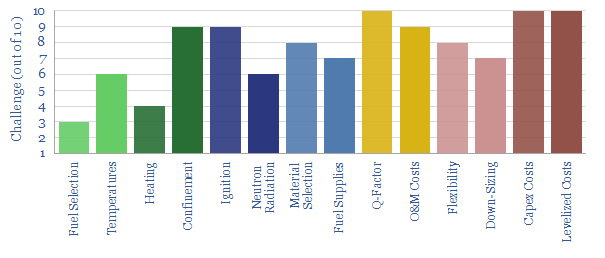Nuclear fusion could provide a limitless supply of zero-carbon energy from the 2030s onwards. Thus 30 private companies have raised $4bn to progress new ideas. But the goal of this 20-page note is simply to understand the challenges of nuclear fusion, especially deuterium-tritium tokamaks. Innovations need to improve EROI, stability, longevity and ultimate costs.
The purpose of this note is to help decision-makers understand nuclear fusion, simply, in plain language, assuming that you are reasonably literate in science and economics, but do not have a pre-existing degree in nuclear physics.
Binding energies of atomic nuclei are a fundamental force shaping our universe. They explain why some atoms release energy as they fission, and some atoms release energy as they fuse. It is easy to quantify ‘how much energy’ using pages 2-3 of the report.
So is it a real and feasible energy source? We outline why it is on page 4. But what are the fourteen nuclear fusion challenges that a reactor will need to overcome?
Heating up nuclear fusion fuel is covered on pages 4-7, covering possible fuel selections, the ‘Coulomb barrier’ for achieving fusion, and heating methods that can surpass 100M C temperatures.
Confining plasma is covered on pages 8-9, explaining how super-conducting magnets can levitate a stream of super-heated, charged particles. Or not.
Ignition of plasma. What happens to the reaction products? How do you harness the heat? Without the reactor melting? Without other safety issues? We answer these questions on pages 10-12.
Practical considerations for running a fusion reactor are: How do you source, purify and inject fuels to the reactor? What energy gain factor is needed? What maintenance requirements and costs? How flexible will the reactor be? Can reactors be down-sized? We answer these questions on pages 13-17.
Economic considerations. Limitless energy does not necessarily mean cheap energy. At the moment, we think fusion could reach commerciality in the 2030s, but it will ‘split the global CO2 abatement cost curve’ into two. Effectively there would be no need for abatement options costing more than $200-300/ton creating an effective ‘cap’ on all future energy prices.
Our patent review of Commonwealth Fusion, a private fusion company that raised $1.8bn in Series B funding, is linked here.

